The learning notes of the MOOC “JavaScript: Understanding the Weird Parts” on Udemy,including most important parts of JavaScript.
- Course link: JavaScript: Understanding the Weird Parts
- My Certification: UC-CWVEBCC5
Basic concept
Conceptual Aside
Conceptual Aside:
- Syntax Parser: a program that reads your code and determines what it does and if its grammer is valid
- Lexical Environment: where something sits physically in the code you write
- Execution Context: a wapper to help manage the code that is running
- Name/Value Pair: a name which maps to a unique value
Object: A collection of Name/Value pairs
undefined: a special value/a special keyword that JavaScript has within it internally that means that the value hasn’s been set.It means that this is the value that was initially set by JavaScript.
- single threaded: one command is being executed at a time.It may not be under the hood of the browser.
synchronous: one at a time and in order.
dynamic typing: you don’t tell the engine what type of data a variable holds,it figures it out while your code is running.
- operator: a special function that is syntatically (written) differently.
coercion: converting a value from one type to another.
by value vs. by reference: all primitive types are by value and all objects are by reference.
array: collections of anything.
inheritance: one object gets access to the properties and methods of another object.
- built-in function constructors: objects created by them have all the properties and methods on the functions’
prototypeproperty and what’s boxed inside of it is the primitive value itself.The built-in function constructors look like you’re creating primitives but you’re not,you are creating objects that contain primitives with a whole bunch of features.
Framework Aside
Framework Aside:
- default value: e.g.
window.libName = window.libName || "lib 1" - namespace: a container for variables and functions.
- function overloading: JavaScript doesn’t have it.There are other appoaches to deal with it.
- whitespace: invisible characters that create literal “space” in your written code,like carriage returns,tabs, or spaces.
- IIFEs and safe code: by wrapping code in an immediately invoked function, does not interfere with crash into,or be interfered by any other code that might be included in your application.
- function factory: a function that returns or makes other things for you.
Dangerous Aside
Dangerous Aside:
- automatic semicolon insertion: if you’re going to return an object from a function,you need to type the
{right afterreturnrather than in a new line. newand functions: don’t forget the key wordnewin front of the function constructors,or you’ll probably getundefinedreturned and cause in trouble.You’d better always have a capital letter as the name of the constructor.- built-in function constructors: strange things can happen during comparison with operator and coercion.In general,it’s better not to use them.Use literals.
- arrays and
for..in: in the case of arrays,don’t usefor..inbecause arrays are objects in JavaScrip and their items are added properties.
Execution Context and Lexical Environment
Execution Context
Execution Context(Global) was created at global level by the JavaScrip engine, and two things were also created for you:
- Global Object
- A special valiable called
this
When you open the file inside your browser, this object is the window object,which refers to the browser window.That is to say:this object equals window object at global level in this case.
Global means “Not Inside a Funciton”. Global variables and functions get attached to the global object.
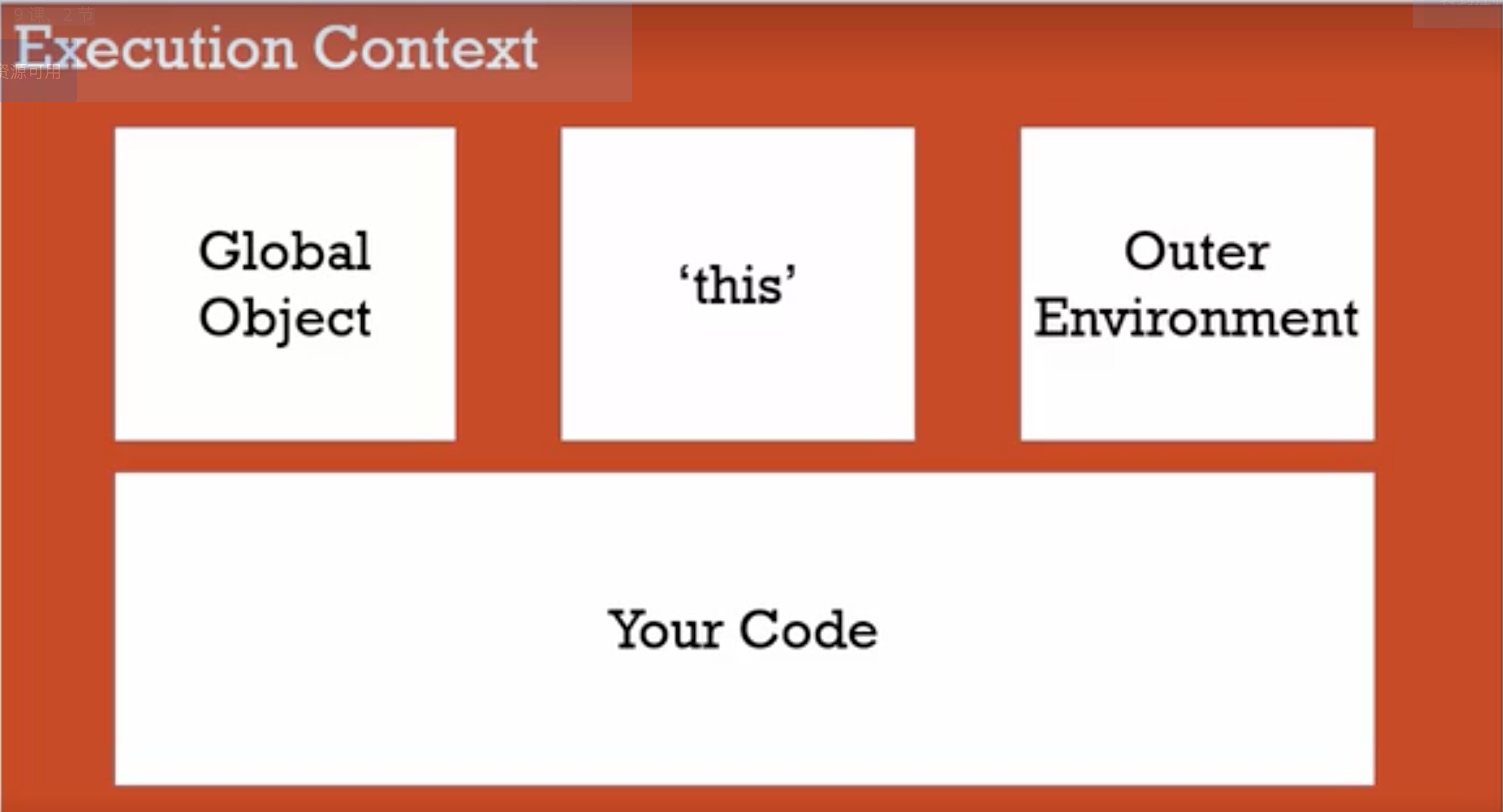
hoisting: variables and functions are to some degree available even though they’re written later in the code.
The phenomenon is because the exection context is created in two phases.
- creation phase: global object and
thisset up in memory,an outer environment, also set up memory space for variables and functions(this step called hoisting). - execution phase: runs the code you’ve written line by line,interpreting it,covering it,compling it,executing it.
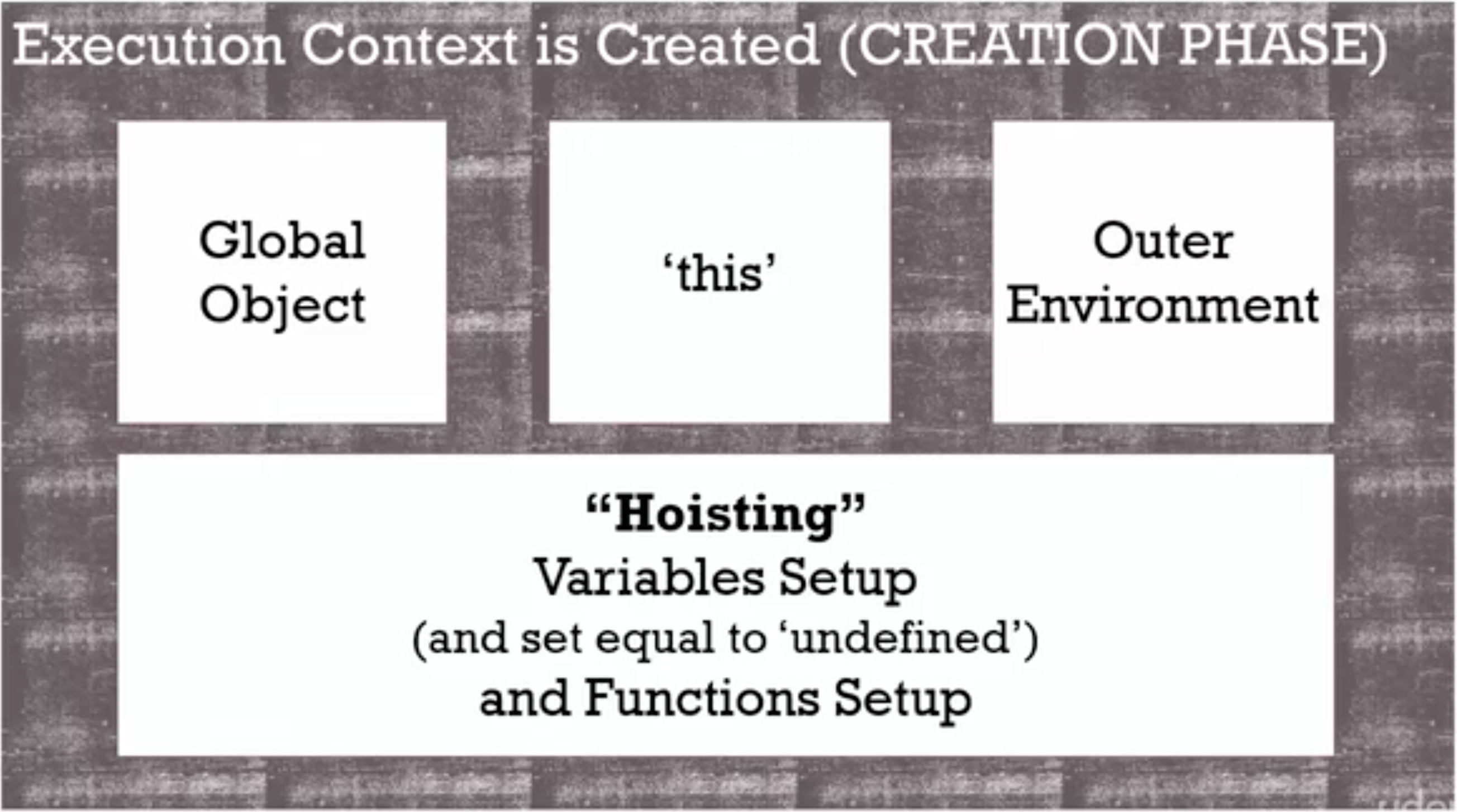
All variables in JavaScript are initally set to undefined,and functions are sitting in memory in their entirety.
Function Invocation
invocation: running a function.In JavaScrip,by using parenthesis().
Execution Stack: top execution context in the stack is the currently executing function.A new execution context is created and put on top of the stack for the function invoked,and popped off the stack when the function finished.
Variable Environment: where the variables live.And how they relate to each other in memory.
Every execution context has a reference to its outer environment.(that is to say,to its lexical environment)
execution context vs. outer environment reference:
- execution context is created when you invoke a function.
- outer environment reference is created for the execution context and it looks at where the code is physically written in the JavaScrip file.(A different way of thinking about it: the outer reference is to the execution context in which the function was created.)
Here is an example:
1 | function c(){ |
Scope Chain:those links of outer environment references where you can access variables.
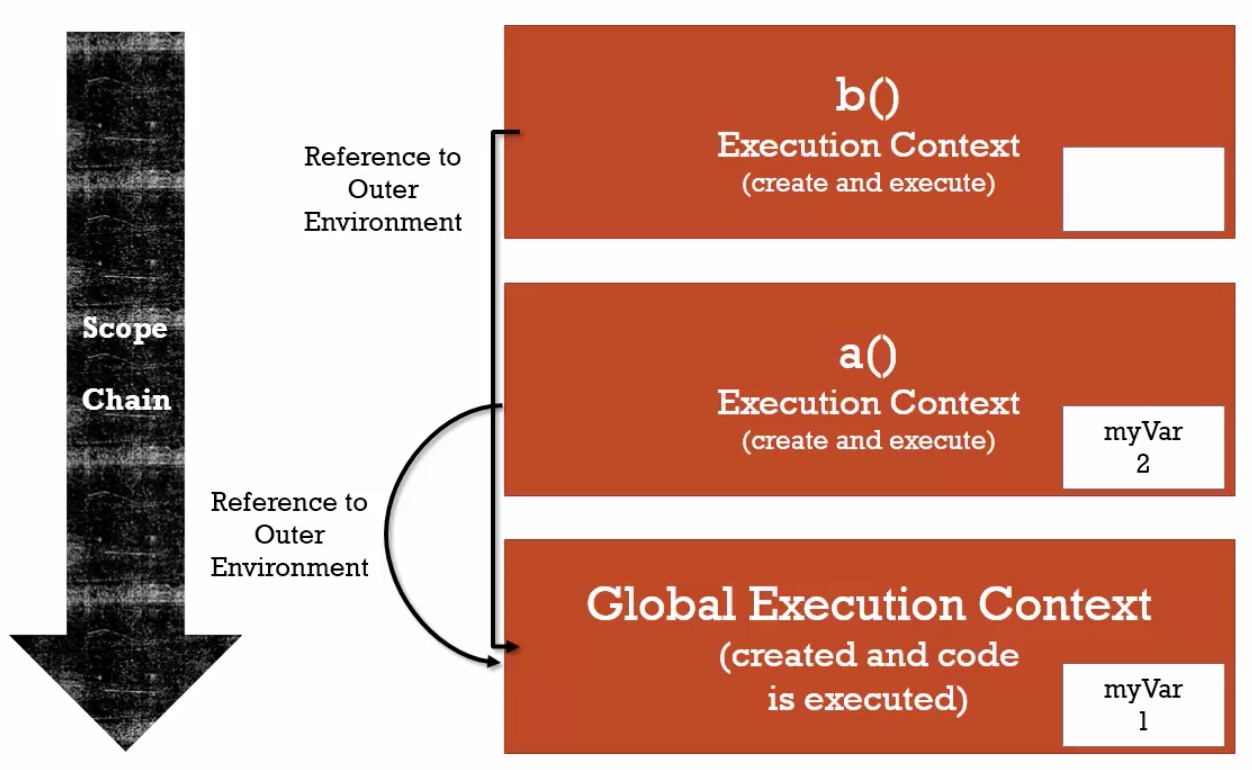
scope: where a variable is available in your code.
asynchronous: more than one at a time.(Asynchronous part is about what’s happening outside the JavaScrip engine rather than inside it.)

Any events that happen outside of the engine get placed into the event queue,an if the execution stack is empty,if JavaScrip isn’t working on anything else currently,it’ll process those events in the order they happend via the event loop synchronously.
Types and Operators
There are six primitive types in JavaScrip.
primitive type: a type of data that represents a single value.That is,not an object.
- undefined: represents lack of existence
- null: represents lack of existence
- boolean: true or false
- number: floating point number.There’s only one ‘number’ type.
- string: a sequence of characters.Both
'and"can be used. - symbol: used in ES6
precedence and associativity:
- operator precedence: which operator function gets called first.
- associativity: what order operator functions get called in: left-to-right or right-to-left.
Reference: Operator precedence
== vs. ===
==will try to coerce the values if the two values are not the same type.===doesn’t try to coerce the values.It’s strict equality.
Reference: Equality comparisons and sameness
The example below shows the usage of coercion to check for existence and is used in a lot of really great frameworks and libraries.
1 | var a; |
or opertator ||: if you passed it two values that can be coerced to true and false,it will return the first one that coerces to true.
Objects and Functions
Object have properties and methods:
- Primitive “property”
- Object “property”
- Function “method”

Both [] and . can find the property on the object and give you the value.
1 | var person = new Object(); |
Object literal vs. JSON string
- The object literal syntax uses the curly braces to define name and value pairs separated by colons.
- JSON stands for JavaScript Object Notation.It looks like object literal syntax except for some differences.For example,property names have to be wrapped in quotes.JSON is technically a subset of the object literal syntax.
JSON.stringify({firstname : "Brian", student: true})JSON.parse('{"firstname":"Brian","student":true}');
First class functions: everything you can do with other types, you can do with functions.(Assign them to variables,pass them around,create them on the fly.)
In JavaScrip,functions are objects.The function is an object with other properties,that is to say, a function is a special type of object.Two main other properties:
- it has a hidden optional name property which can be anonymous then if you don’t have a name.
- we have code property that contains the code and that code property is invocable so we can run the code.

expression: a unit of code that results in a value.
Statement just does work and an expression results in a value.
mutate: to change something.
The keyword this points to what? Let’s see an example.
1 | var c = { |
In the example above,the internal function setname when its execution context was created,the this keyword points to the global object,even though it’s sitting kind of inside an object that I created.To avoid this case,just use var self = this;(set equal to by reference) as the very first line of your object method.
An array can be created in the following formmat:
var arr = new Array();var arr = [1, 2, 3];
Array in JavaScript is zero based and dynamically typed,it figures out what type of things are on the fly.
arguments: the parameters you pass to a function.JavaScript gives you a keyword of the same name which contains them all.Although arguments doesn’t contain the names of arguments,just the values,you could use it like an array.A new thing is called a spread parameter....other means take everything else and wrap it into an array of this name “other”.
IIFEs
IIFEs - an immediately invoked function expressions
1 | // using an Immediately Invoked Function Expression (IIFE) |
To wrap your function in parentheses.This is when you want a function expression instead of normal function statement.
1 | //valid syntax but output nothing |
understanding closures
Even though the outer function ended/finished,any functions created inside of it when they are called will still have a reference to that outer function’s memory.
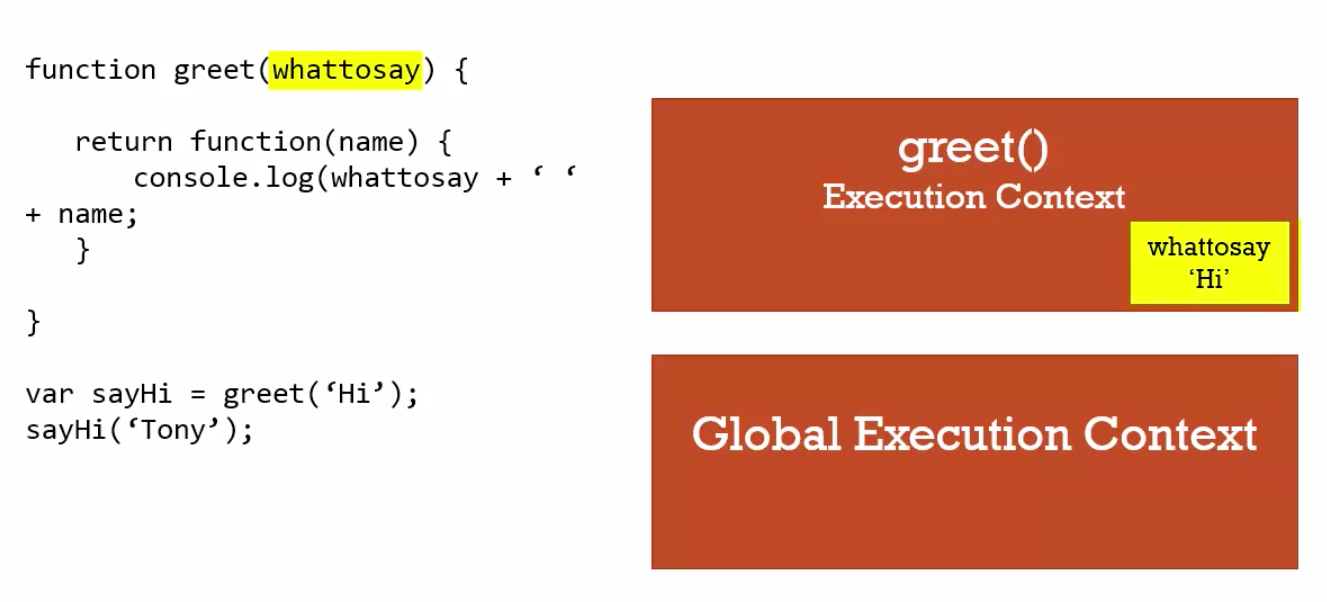
Outer function is gone,the exectution context is gone.But what’s in memory for that execution context isn’t and JavaScript engine makes sure that the inner function can still go down the scope chain and find it.
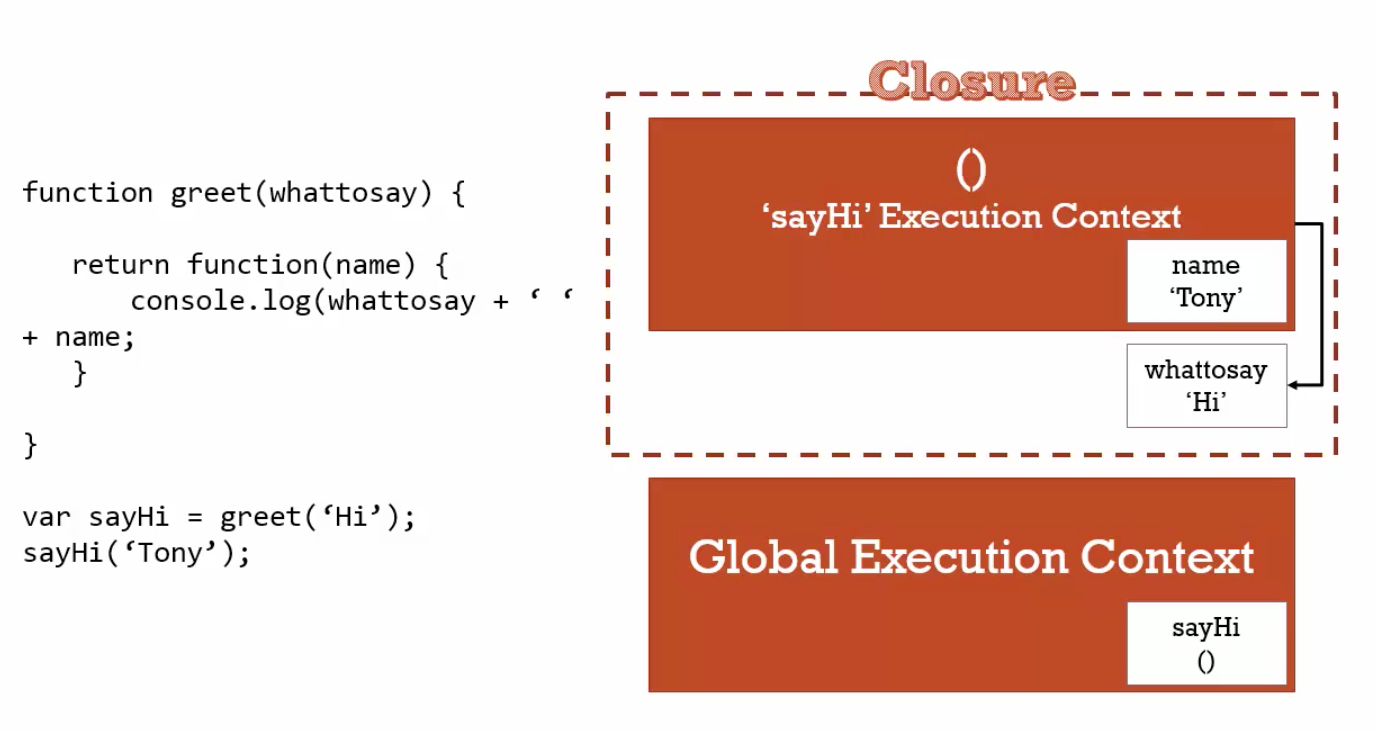
In this way we say that the execution context has closed in its outer variables.And so this phenomenon,of it closing in all the variables that it’s supposed to have access to,is called a closure. This is the feature of the language JavaScript,very important.
callback function: a function you give to another function,to be run when the other function is finished.
call(),apply() and bind()
All functions in JavaScript also get access to some special functions/methods, on their own.So all functions have access to a call method,an apply method and a bind method.
bind()creates a new copy of whatever function you’re calling it on.And then whatever object you pass to this method is what thethisvariable points to by reference.call()invokes the function you’re calling it on.Also let you decide what thethisvariable will be.Unlikebind()which creates a new copy,call()actually executes it.apply()does the exact same thing ascall()except that it wants an array of parameters as the second parameter rather than just the normal list.
These functions can be used for function borrowing and function currying.
function currying: creating a copy of a function but with some preset parameters.
some open source libraries:
Object-Oriented JavaScript and Prototypal Inheritance
Classical vs. Prototypal Inheritance:
- Classical Inheritance: verbose
- Prototypal Inheritance: simple
All objects include functions hava a prototype property.The prototype is simply a reference to another object.
The prototype chain,the concept of prototypes is just I have this special reference in my object that says where to look for other properties and methods without manually going dot prototype.
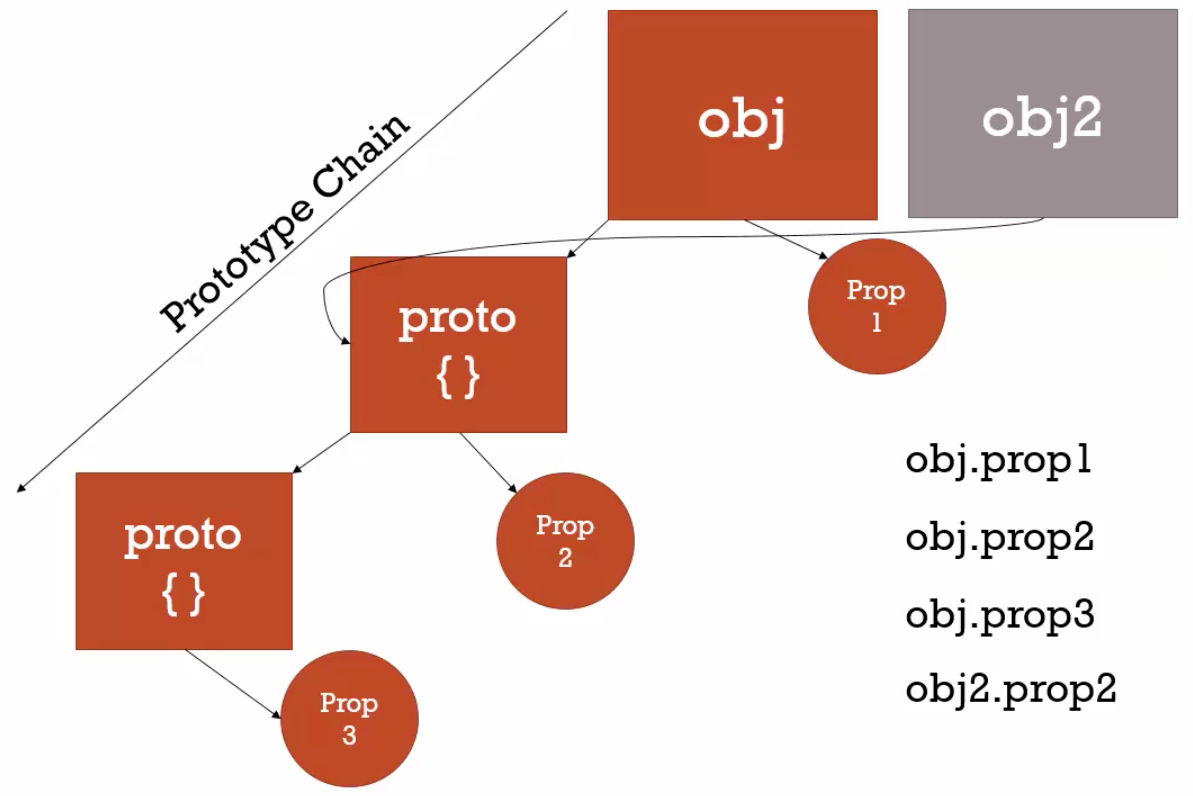
reflection: an object can look at itself,listening and changing its properties and methods.
tip: the “for in” actually reached out and grabbed every property and method not just on the object but also on the object’s prototype
extend: here we just talk about the extend function in underscore.You can combine and compose objects in this extend pattern with relection,not just the prototype pattern.
Building Objects
function constructors: a normal function that is used to construct objects.(The this variable points a new empty object,and that object is returned from the function automatically.)
There are many approaches to building an object:
- object literal syntax:
{} - the key word
new:var john = new Person();- first, an empty object is created.
- then, it invokes the function with the
thisvariable pointing to that empty object. - last, return the object if you don’t return anything explicitly,or return what is returned in the function.
Object.create: creates an empty object with its prototype pointing at whatever you have passed in toObject.create.- you can simply override/hide properties and methods on those created objects by setting the values of those properties and methods on new objects themselves.
- ES6 and classes: another approach but still works the same under the hood,just syntactic sugar.
- key word
class: class is not the template or definition like other languages such as Java/C++,class is also an object. - key word
extends: sets the prototype(__prototype__) for any of the objects created with this class.
- key word
.prototype: this prototype property of all functions is where the prototype chain points for any objects created using that function as a constructor.
- The
prototypeproperty on a function is not the prototype property(__prototype__) of the function. - It’s used only by the
newoperator.In other cases,it’s just an empty object,hanging out there. - It’s the prototype of any objects created if you’re using the function as a function constructor.
- takes up less memory space if you add method to the prototype because it’ll only have one,while it’ll have many copies if you add it to function constructor.
polyfill: code that adds a feature which the engine may lack.
1 | // polyfill |
syntactic sugar: a different way to type something that doesn’t change how it works under the hood.
Odds and Ends
initialization: when come accross a large initialization of objects,don’t get overwhelmed by the syntax.
typeof and instanceof:
typeof: it’s an operator(essentially a function) that takes a parameter returns a string.It will tell you under most cases what something is.Object.prototype.toString.call(arr)gets array type([object Array]) returned,or you’ll getobjectreturned.typeof undefinedreturnsundefinedtypeof nullreturnsobject.It’s been a bug since forever.
instanceof: tells if any object is down the prototype chain.It will tell you what something has in its prototype chain.
transpile: convert the syntax of one programming language to another.
- Typescript
- Traceur(Traceur is a JavaScript.next-to-JavaScript-of-today compiler)
- features of ECMAScript 6
